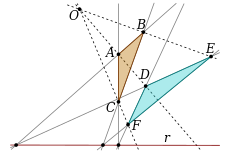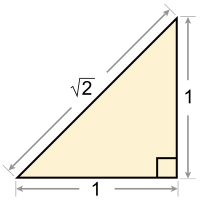Geometry
Geometry (from the Ancient Greek: γεωμετρία; geo- "earth", -metron "measurement") is a branch of mathematics concerned with questions of shape, size, relative position of figures, and the properties of space. A mathematician who works in the field of geometry is called a geometer.
Geometry arose independently in a number of early cultures as a practical way for dealing with lengths, areas, and volumes. Geometry began to see elements of formal mathematical science emerging in the West as early as the 6th century BC.[1] By the 3rd century BC, geometry was put into an axiomatic form by Euclid, whose treatment, Euclid's Elements, set a standard for many centuries to follow.[2] Geometry arose independently in India, with texts providing rules for geometric constructions appearing as early as the 3rd century BC.[3] Islamic scientists preserved Greek ideas and expanded on them during the Middle Ages.[4]By the early 17th century, geometry had been put on a solid analytic footing by mathematicians such as René Descartes and Pierre de Fermat. Since then, and into modern times, geometry has expanded into non-Euclidean geometry and manifolds, describing spaces that lie beyond the normal range of human experience.[5]
While geometry has evolved significantly throughout the years, there are some general concepts that are more or less fundamental to geometry. These include the concepts of points, lines, planes, surfaces, angles, and curves, as well as the more advanced notions of manifolds and topology or metric.[6]
Geometry has applications to many fields, including art, architecture, physics, as well as to other branches of mathematics.
History
The earliest recorded beginnings of geometry can be traced to ancient Mesopotamia and Egypt in the 2nd millennium BC.[8][9] Early geometry was a collection of empirically discovered principles concerning lengths, angles, areas, and volumes, which were developed to meet some practical need in surveying, construction, astronomy, and various crafts. The earliest known texts on geometry are the Egyptian Rhind Papyrus (2000–1800 BC) and Moscow Papyrus (c. 1890 BC), the Babylonian clay tablets such as Plimpton 322 (1900 BC). For example, the Moscow Papyrus gives a formula for calculating the volume of a truncated pyramid, or frustum.[10] Later clay tablets (350–50 BC) demonstrate that Babylonian astronomers implemented trapezoid procedures for computing Jupiter's position and motion within time-velocity space. These geometric procedures anticipated the Oxford Calculators, including the mean speed theorem, by 14 centuries.[11] South of Egypt the ancient Nubians established a system of geometry including early versions of sun clocks.[12][13]
In the 7th century BC, the Greek mathematician Thales of Miletus used geometry to solve problems such as calculating the height of pyramids and the distance of ships from the shore. He is credited with the first use of deductive reasoning applied to geometry, by deriving four corollaries to Thales' Theorem.[1]Pythagoras established the Pythagorean School, which is credited with the first proof of the Pythagorean theorem,[14] though the statement of the theorem has a long history.[15][16] Eudoxus (408–c. 355 BC) developed the method of exhaustion, which allowed the calculation of areas and volumes of curvilinear figures,[17] as well as a theory of ratios that avoided the problem of incommensurable magnitudes, which enabled subsequent geometers to make significant advances. Around 300 BC, geometry was revolutionized by Euclid, whose Elements, widely considered the most successful and influential textbook of all time,[18] introduced mathematical rigor through the axiomatic method and is the earliest example of the format still used in mathematics today, that of definition, axiom, theorem, and proof. Although most of the contents of the Elements were already known, Euclid arranged them into a single, coherent logical framework.[19] The Elements was known to all educated people in the West until the middle of the 20th century and its contents are still taught in geometry classes today.[20]Archimedes (c. 287–212 BC) of Syracuse used the method of exhaustion to calculate the area under the arc of a parabola with the summation of an infinite series, and gave remarkably accurate approximations of Pi.[21]He also studied the spiral bearing his name and obtained formulas for the volumes of surfaces of revolution.

Woman teaching geometry. Illustration at the beginning of a medieval translation of Euclid's Elements, (c. 1310)
Indian mathematicians also made many important contributions in geometry. The Satapatha Brahmana (3rd century BC) contains rules for ritual geometric constructions that are similar to the Sulba Sutras.[3] According to (Hayashi 2005, p. 363), the Śulba Sūtras contain "the earliest extant verbal expression of the Pythagorean Theorem in the world, although it had already been known to the Old Babylonians. They contain lists of Pythagorean triples,[22] which are particular cases of Diophantine equations.[23] In the Bakhshali manuscript, there is a handful of geometric problems (including problems about volumes of irregular solids). The Bakhshali manuscript also "employs a decimal place value system with a dot for zero."[24] Aryabhata's Aryabhatiya (499) includes the computation of areas and volumes. Brahmagupta wrote his astronomical work Brāhma Sphuṭa Siddhānta in 628. Chapter 12, containing 66 Sanskrit verses, was divided into two sections: "basic operations" (including cube roots, fractions, ratio and proportion, and barter) and "practical mathematics" (including mixture, mathematical series, plane figures, stacking bricks, sawing of timber, and piling of grain).[25] In the latter section, he stated his famous theorem on the diagonals of a cyclic quadrilateral. Chapter 12 also included a formula for the area of a cyclic quadrilateral (a generalization of Heron's formula), as well as a complete description of rational triangles (i.e. triangles with rational sides and rational areas).[25]
Important concepts in geometry
Axioms
Points
Lines
Planes
Curves
Angles
Surfaces
Manifolds
Topologies and metricsCompass and straightedge constructions
Dimension
Symmetry
Non-Euclidean geometry
Applications
Geometry has found applications in many fields, some of which are described below.
Art
Mathematics and art are related in a variety of ways. For instance, the theory of perspective showed that there is more to geometry than just the metric properties of figures: perspective is the origin of projective geometry.
Architecture
Mathematics and architecture are related, since, as with other arts, architects use mathematics for several reasons. Apart from the mathematics needed when engineering buildings, architects use geometry: to define the spatial form of a building; from the Pythagoreans of the sixth century BC onwards, to create forms considered harmonious, and thus to lay out buildings and their surroundings according to mathematical, aesthetic and sometimes religious principles; to decorate buildings with mathematical objects such as tessellations; and to meet environmental goals, such as to minimise wind speeds around the bases of tall buildings.
Physics

The 421polytope, orthogonally projected into the E8Lie group Coxeter plane. Lie groups have several applications in physics.
The field of astronomy, especially as it relates to mapping the positions of stars and planets on the celestial sphere and describing the relationship between movements of celestial bodies, have served as an important source of geometric problems throughout history.
Modern geometry has many ties to physics as is exemplified by the links between pseudo-Riemannian geometry and general relativity. One of the youngest physical theories, string theory, is also very geometric in flavour.
Other fields of mathematics
Geometry has also had a large effect on other areas of mathematics. For instance, the introduction of coordinates by René Descartes and the concurrent developments of algebra marked a new stage for geometry, since geometric figures such as plane curves could now be represented analytically in the form of functions and equations. This played a key role in the emergence of infinitesimal calculus in the 17th century. The subject of geometry was further enriched by the study of the intrinsic structure of geometric objects that originated with Euler and Gauss and led to the creation of topology and differential geometry.
An important area of application is number theory. In ancient Greece the Pythagoreans considered the role of numbers in geometry. However, the discovery of incommensurable lengths, which contradicted their philosophical views, made them abandon abstract numbers in favor of concrete geometric quantities, such as length and area of figures. Since the 19th century, geometry has been used for solving problems in number theory, for example through the geometry of numbers or, more recently, scheme theory, which is used in Wiles's proof of Fermat's Last Theorem.
While the visual nature of geometry makes it initially more accessible than other mathematical areas such as algebra or number theory, geometric language is also used in contexts far removed from its traditional, Euclidean provenance (for example, in fractal geometry and algebraic geometry).[53]
Analytic geometry applies methods of algebra to geometric questions, typically by relating geometric curves to algebraic equations. These ideas played a key role in the development of calculus in the 17th century and led to the discovery of many new properties of plane curves. Modern algebraic geometry considers similar questions on a vastly more abstract level.
Leonhard Euler, in studying problems like the Seven Bridges of Königsberg, considered the most fundamental properties of geometric figures based solely on shape, independent of their metric properties. Euler called this new branch of geometry geometria situs (geometry of place), but it is now known as topology. Topology grew out of geometry, but turned into a large independent discipline. It does not differentiate between objects that can be continuously deformed into each other. The objects may nevertheless retain some geometry, as in the case of hyperbolic knots.




No comments:
Post a Comment